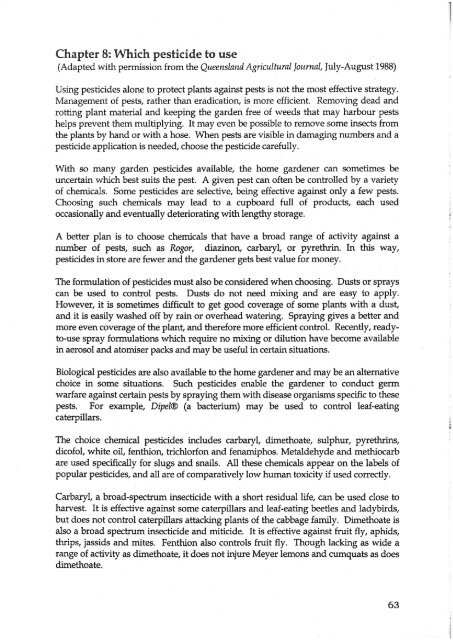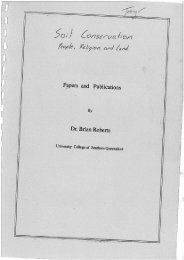western-queensland-gardening-guide.pdf - South West NRM
western-queensland-gardening-guide.pdf - South West NRM
western-queensland-gardening-guide.pdf - South West NRM
You also want an ePaper? Increase the reach of your titles
YUMPU automatically turns print PDFs into web optimized ePapers that Google loves.
Chapter 8:<br />
ich pesticide to use<br />
(Adapted with permission from the Queenslnnd Agricultural lournal, July-August 1988)<br />
Using pesticides alone to protect plants against pests is not the most effective strategy.<br />
Management of pests, rather than eradication, is more efficient. Removing dead and<br />
rotting plant material and keeping the garden free of weeds that may harbour pests<br />
helps prevent them multiplying. It may even be possible to remove some insects from<br />
the plants by hand or with a hose. en pests are visible in damaging numbers and a<br />
pesticide application is needed, choose the pesticide carefully.<br />
With so many garden pesticides available, the home gardener can sometimes be<br />
uncertain which best suits the pest. A given pest can often be controlled by a variety<br />
of chemicals. Some pesticides are selective, being effective against only a few pests.<br />
Choosing such chemicals may lead to a cupboard full of products, each used<br />
occasionally and eventually deteriorating with lengthy storage.<br />
A better plan is to choose chemicals that have a broad range of activity against a<br />
number of pests, such as Rogor, diazinon, carbaryl, or pyrethrin. In this way,<br />
pesticides in store are fewer and the gardener gets best value for money.<br />
lation of pesticides must also be considered when choosing. Dusts or sprays<br />
can be used to control pests. Dusts do not need ing and are easy to apply.<br />
However, it is some s difficult to get good cover of some plants with a dust,<br />
and it is easily washed off by rain or overhead watering. Spraying gives a better and<br />
more even coverage of the plant, and therefore more efficient control. Recently, readyto-use<br />
spray fo lations which require no ing or dilution have become available<br />
in aerosol and atomiser packs and may be useful in certain situations.<br />
Biological pesticides are also available to the home gardener and may be an alternative<br />
choice in some situations. Such pesticides enable the gardener to conduct germ<br />
warfare against certain pests by spraying them with disease organisms specific to these<br />
pests. For example, Dipelm (a bacterium) may be used to control leaf-eating<br />
caterpillars.<br />
The choice chemical pesticides includes carbaryl, dimethoate, sulphur, pyrethrins,<br />
dicofol, white oil, fenthion, trichlorfon and fenamiphos. Metaldehyde and methiocarb<br />
are used specifically for slugs and snails. All these chemicals appear on the labels of<br />
popular pesticides, and all are of comparatively low human toxicity if used correctly.<br />
Carbaryl, a broad-spectrum insecticide with a short residual life, can be used close to<br />
hamest. It is effective against some caterpillars and leaf-eating beetles and ladybirds,<br />
but does not control caterpillars attacking plants of the cabbage family. Dimethoate is<br />
also a broad spectrum insecticide and miticide. It is effective against fruit fly, aphids,<br />
thrips, jassids and mites. Fenthion also controls fruit fly. Though lacking as wide a<br />
range of activity as dimethoate, it does not injure Meyer lemons and cumquats as does<br />
dimethoate.
















